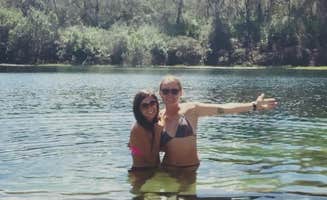Dispersed camping spots in the Ocala National Forest provide primitive camping opportunities near Orange City, Florida. The region features sandy soils and subtropical forest vegetation with elevations ranging from 10-100 feet above sea level. Weather conditions include high humidity levels during summer months with frequent afternoon thunderstorms between June and September.
What to do
River paddling access points: The Ocklawaha River at Davenport Landing offers a natural entry point for paddlers. "If you are looking to catch and eat your meals, then this will certainly be an added bonus. The steps down the ravine to the river basin are somewhat steep, but for anyone towing a light-weight kayak or paddleboard, me thinks you could likely manage to bring your watercraft down here," notes a camper.
Historical exploration: A 1.2-mile interpretive trail at Davenport Landing leads to remnants of a historic steamboat landing. "If you have an explorer's mindset, you'll be richly rewarded here as there is a small gravesite from the Civil War that you can find along with middens along the Ocklawaha River hiding traces of the Timucuan Indians that once populated this area," explains one visitor.
Night sky viewing: The forest canopy at several sites opens to clear night skies. At St. Johns River Dispersed Spot, one camper shared, "Right next to the river and the trees open up so you get a great view of the stars."
What campers like
Secluded swimming spots: Freak Creek Dispersed Camping offers water access that appeals to adventurous campers. "Great place to put a kayak in the water," notes one reviewer, while another mentions "There is a nice creek area where you can swim and or fish if you have the right equipment to get back there."
Shade coverage: The magnolia canopy at Davenport Landing provides natural shelter from Florida sun. A visitor described: "Here at literally 'the end of the road,' you'll be greeted by a dozen or so medium-sized Magnolias that blot out the sun's rays and cast an unusually spooky shadow on this area, made even more dramatic by all of the Spanish moss falling from the tree limbs."
Wildlife spotting opportunities: The primitive camping areas support diverse wildlife viewing. One camper at Davenport Landing mentions local fishermen advised "to be on the look-out for 'Coyo-Dogs' (a cross between canine species where a dog mates with a coyote) and black bear, both of which have been known to frequent this area, especially at night."
What you should know
Vehicle clearance requirements: Most primitive camping spots require high-clearance vehicles, with Trout Lake Primitive Sites having particularly challenging access. "Very narrow trails but really easy access, you will leave with some new pinstripes," warns one camper. Another adds, "The trail to the lake is so narrow I wasn't sure I was driving my Chevy Malibu through the forest because it was so overgrown."
Cell service limitations: Communication can be unreliable in remote camping areas. At Trout Lake, a camper noted "Poor cell service even with booster. Plan on returning after antenna upgrade." Another visitor recounted being "scared to death all night alone, I had a black bear sighting that afternoon and I had no bear spray no cellphone service."
Seasonal road conditions: Sand and water crossings become more challenging after rain. One visitor to Freak Creek reported, "The main road in has huge deep ruts, the other road has a water crossing that was over my bumper on my lifted Mojave... If you don't have 4wd and recovery gear I wouldn't risk it."
Tips for camping with families
Safer sites for children: Choose locations with established boundaries and easier emergency exit routes. Some areas have concerning safety reports, while others are more family-appropriate. At Lake Dorr, a visitor warned, "Attempted to stay at this campground but left because it felt unsafe. Spoke to a local that warned of violence, robbery, and killings in this area of the national forest."
Weather preparation: Summer camping requires careful planning for afternoon thunderstorms. Trout Lake campers shared this experience: "It rained all night and morning. I knew I couldn't drive out or take the risk. I spent the second night." Bring extra tarps and rain gear during summer months.
Wildlife safety equipment: Pack bear spray and sealed food containers. As one camper at Davenport Landing noted, visitors should "keep your eyes peeled for alligators in this area, where while we didn't see any right at the ravine's base, we were told that plenty were sunbathing right around the bend in the river."
Tips from RVers
Vehicle width limitations: Forest roads have extremely narrow passages between trees at many primitive sites. A visitor to Trout Lake reported, "Just barely scraped a FWD Promaster through the trees, into a pullout just before sand started." Standard-width RVs will struggle on most access roads.
Limited turn-around space: Many primitive sites lack adequate space for larger vehicles to turn around. At Davenport Landing, a camper described, "follow the pathway to its conclusion, which is a round-about that you will have no other alternative but to stop and park your vehicle."
Road condition scouting: Some campers recommend walking forest roads before driving an RV through. A camper notes, "Drive further south of the other side of Ron Paul Drive" at Lake Dorr to avoid problematic areas, adding "You'll either get stuck in sand or have issues to low/tight trees."




